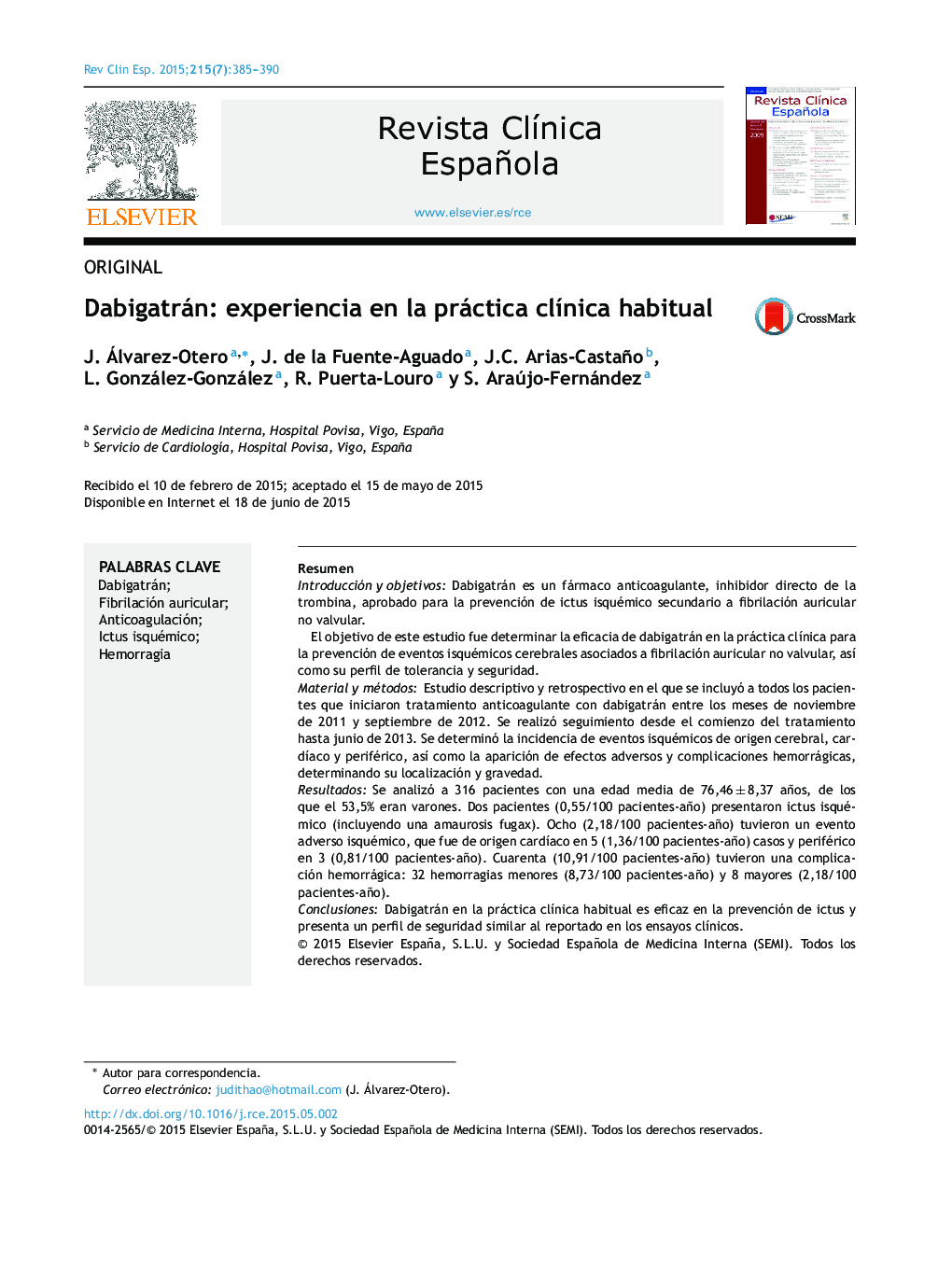| Article ID | Journal | Published Year | Pages | File Type |
|---|---|---|---|---|
| 3826919 | Revista Clínica Española | 2015 | 6 Pages |
ResumenIntroducción y objetivosDabigatrán es un fármaco anticoagulante, inhibidor directo de la trombina, aprobado para la prevención de ictus isquémico secundario a fibrilación auricular no valvular.El objetivo de este estudio fue determinar la eficacia de dabigatrán en la práctica clínica para la prevención de eventos isquémicos cerebrales asociados a fibrilación auricular no valvular, así como su perfil de tolerancia y seguridad.Material y métodosEstudio descriptivo y retrospectivo en el que se incluyó a todos los pacientes que iniciaron tratamiento anticoagulante con dabigatrán entre los meses de noviembre de 2011 y septiembre de 2012. Se realizó seguimiento desde el comienzo del tratamiento hasta junio de 2013. Se determinó la incidencia de eventos isquémicos de origen cerebral, cardíaco y periférico, así como la aparición de efectos adversos y complicaciones hemorrágicas, determinando su localización y gravedad.ResultadosSe analizó a 316 pacientes con una edad media de 76,46 ± 8,37 años, de los que el 53,5% eran varones. Dos pacientes (0,55/100 pacientes-año) presentaron ictus isquémico (incluyendo una amaurosis fugax). Ocho (2,18/100 pacientes-año) tuvieron un evento adverso isquémico, que fue de origen cardíaco en 5 (1,36/100 pacientes-año) casos y periférico en 3 (0,81/100 pacientes-año). Cuarenta (10,91/100 pacientes-año) tuvieron una complicación hemorrágica: 32 hemorragias menores (8,73/100 pacientes-año) y 8 mayores (2,18/100 pacientes-año).ConclusionesDabigatrán en la práctica clínica habitual es eficaz en la prevención de ictus y presenta un perfil de seguridad similar al reportado en los ensayos clínicos.
Introduction and objectivesDabigatran is an anticoagulant drug and a direct thrombin inhibitor and has been approved for the prevention of ischaemic stroke secondary to nonvalvularauricular auricular fibrillation.The aim of this study was to determine the efficacy of dabigatran in clinical practice for preventing cerebral ischaemic events associated with nonvalvularauricular auricular fibrillation, as well as its tolerance and safety profile.Material and methodsA descriptive and retrospective study was conducted, which included all patients who started anticoagulant treatment with dabigatran between November 2011 and September 2012. Follow-up was performed from the start of treatment until June 2013. The incidence of ischaemic events of cerebral, cardiac and peripheral origin was recorded, as was the onset of adverse effects and haemorrhagic complications, whose location and severity were determined.ResultsWe analysed 316 patients, with a mean age of 76.46 ± 8.37 years, of whom 53.5% were men. Two patients (0.55/100 patient-years) presented ischaemic stroke (including one amaurosis fugax). Eight (2.18/100 patient-years) patients had an adverse ischaemic event, whose origin was cardiac in 5 (1.36/100 patient-years) cases and peripheral in 3 (0.81/100 patient-years). Forty (10.91/100 patient-years) patients had a haemorrhagic complication: 32 minor (8.73/100 patient-years) and 8 major (2.18/100 patient-years) haemorrhages.ConclusionsDabigatran is effective in standard clinical practice in preventing stroke and has a safety profile similar to that reported in the clinical trials.
